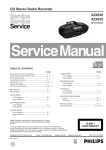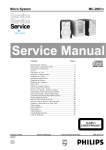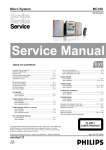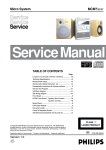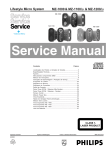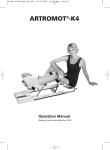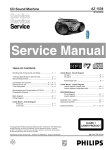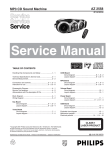Download Philips AZ1141 Specifications
Transcript
CD Stereo Radio Recorder AZ1140 AZ1141 AZ1142 AZ1143 AZ1145 all versions TABLE OF CONTENTS chapter Handling chip components and safety ............................. 1 - 1 Technical Specification & Service Tools.......................... 2 - 1 Service Measurement .................................................. 2 - 2 Connections & Controls ................................................ 3 - 1 Instructions for use ................................................. 3 - 2 to 3 - 6 Disassembly Diagram ................................................... 4 - 1 CD Service Test Program ........................................ 4 - 2 to 4 - 3 chapter MAIN BOARD circuit diagram ....................................................... 10 - 1 layout diagram ....................................................... 10 - 2 Block Diagram ............................................................. 5 - 1 Wiring Diagram ........................................................... 6 - 1 CD MODULE circuit diagram ....................................................... 12 - 2 layout diagram ....................................................... 12 - 1 CONTROL BOARD circuit diagram ................................................... 7 - 1, 7 - 3 layout diagram ....................................................... 7 - 2 SWITCH & VOLUME BOARD layout diagram ....................................................... 8 - 1 RECORDER & BEAT CUT BOARD circuit diagram ....................................................... 11 - 1 layout diagram ....................................................... 11 - 2 EXPLODED VIEWS DIAGRAM cabinet ................................................................. 13 - 1 tape deck ............................................................ 13 - 2 Mechanical partslist ..................................................... 13 - 2 Electrical partslist ............................................... 14 - 1 to 14 - 4 TUNER BOARD circuit diagram ....................................................... 9 - 1 layout diagram ....................................................... 9 - 2 Safety regulations require that the set be restored to its original condition and that parts which are identical with those specified be used. CLASS 1 LASER PRODUCT C Copyright 1995 Philips Consumer Electroncis B.V. Eindhoven,The Netherlands All rights reserved. No part of this publication may be reproduced, stored in a retrieval system or transmitted, in any form or by any means, electronic, mechanical, photocopying, or otherwise without the prior permission of Philips. Published by SS 0024 Service Audio PCS 104 409 Printed in The Netherlands Copyright reserved Subject to modification GB 3140 785 22260 2-1 TECHNICAL SPECIFICATIONS GENERAL Mains voltage Mains frequency Battery Power consumption TUNER - AM SECTION -/00 -/01/11/16 -/05/10 -/17 -/00/05/10 -/01/11/16 -/17 mains Remote normal standby Dimension (W x H x D) Weight : : : : : : : : : : : : : 230 V 120/230 V 240 V 120 V 50 Hz 50 / 60 Hz 60 Hz 9 V (R14 x 6) 3V (R03 x 2) 10 W 2W 290 x 152 x 253 mm 2.6 Kg Tuning range MW : 531 - 1602 kHz -/17 : 520 - 1730 kHz LW : 153 - 279 kHz : 450 kHz ± 1 kHz MW : 64 dBu at 26dB S/N LW : 70 dBu at 26dB S/N IF frequency Sensitivity Selectivity MW : 22dB IF rejection ratio Image rejection ratio LW MW LW MW LW : : : : : 29 dB 70 dB 70 dB 32 dB 35 dB AUDIO CASSETTE RECORDER AMPLIFIER Output power Speaker impedance Frequency response mains : 2 x 1.6 W battery : 2 x 2 W : 2 x 4 ohm : 100 Hz - 8 kHz (±3dB) : : : P/B : : ± 3% < 0.35 % JIS WTD < 120 sec. 125 – 6.3 kHz 45 dB COMPACT DISC TUNER - FM SECTION Tuning range IF frequency Sensitivity Selectivity IF rejection Image rejection Tape speed accuracy Wow & flutter Fast wind/rewind C60 Frequency response S/N ratio : : : : : : 87.5 - 108 MHz 10.7 MHz ± 0.2 MHz 16 dBf at 26dB S/N 55 dB at ± 300kHz 85 dB 40 dB Frequency response S/N ratio Channel difference Channel crosstalk Laser wavelength Laser light power : : 1 kHz : 1 kHz : : : 100 Hz - 10 kHz > 50 dB < 3 dB > 26 dB 780 ± 20nm < 0.3 mW SERVICE TOOLS Audio signal disc SBC 429.......................................................................4822 397 30184 Playability test disc SBC 444...................................................................4822 397 30245 Test disc 5 (disc without errors ) + Test disc 5A (disc with dropout errors, black spots and fingerprints) SBC 426/426A.....................................................................4822 397 30096 Burn in test disc (65 min. 1kHz signal at -30 dB level without “pause”) .....4822 397 30155 Universal test cassette Fe SBC 420 ........................................................4822 397 30071 PCS 104 410 * TAPE CD MO OFF VO L USE STOP PLAY•PA B OO ST DY NA MI C BA SS DE TU NE R BATT LOW DB B CD PAU SE DY NA SS % BA BO T UN OS ER RDER H SEARC RECO 145 CASS ETTE ITA L M IC D IG AZ1 DIO CD RA REPEAT ALL CD PROGRAM P•OPEN STO 234 5 !@ #$ 1 T ( PROGRA M SEA RCH REMOTE SENSOR RECOR D £ ™ ¡ ) ( ^ & PLAY 67 5 2 4 6 9 1 8 2 l ND REPE AT TUNIN G SEAR CH eC ontro tal R emot STO LE BA VOLU ME ET P ES PRES ET PR SHUFF SEAR CH Digi 3 9 0 1 3 5 7 8 1 VOLUME 3,4 – adjusts volume level 2 PRESET 3,4 (up, down) – selects a preset radio station 3 TUNING ∞, § (down, up) – tunes to radio stations 4 SHUFFLE – to play CD tracks in random order 5 REPEAT – repeats a track/ CD programme/ entire CD 6 2; – starts and pauses CD playback/ interrupts CD playback 7 ¡, ™ – skips to the beginning of a current track/ previous/ later track 8 STOP 9 – stops CD playback or erases a CD programme 9 SEARCH 5, 6 – searches backwards or forwards within a track/CD REMOTE CONTROL * p - 3.5 mm stereo headphone socket ( Telescopic aerial - improves FM reception ) BEAT CUT switch - eliminates possible whistle tones during MW (AM) recordings ¡ AC Mains - inlet for mains lead ™ Battery compartment - for six batteries, type R-14, UM-2 or C-cells £ Voltage selector (located inside the battery compartment. Some versions only) - select the correct local voltage 110/220 V before plugging in the set BACK PANEL & PROGRAM Tuner - programmes preset radio stations; CD - programmes tracks and reviews the programme Use of controls or adjustments or performance of procedures other than herein may result in hazardous radiation exposure or other unsafe operation. CAUTION 1 POWER slider - selects the sound source for CD/ TUNER/ TAPE OFF and also switches the set off 2 VOL +, – - adjusts the volume level 3 BATT LOW - indicates when battery power is running low 4 DBB (Dynamic Bass Boost) - enhances the bass 5 OPEN•CLOSE - opens/ closes the CD door 6 CASSETTE RECORDER keys RECORD 0 - starts recording PLAY 1 - starts playback SEARCH 5/ 6 - fast winds/rewinds the tape STOP•OPEN 9/ - stops the tape; - opens the cassette compartment PAUSE ; - interrupts recording or playback 7 Remote sensor - infrared sensor for the remote control 8 1-3 - programmes and selects your favourite three radio stations 9 PRESET 3, 4 - (down, up) selects preset tuner stations 0 BAND - selects waveband ! PLAY PAUSE 2; - starts /pauses CD playback @ CD MODE - selects a different play mode e.g. SHUFFLE/ REPEAT CD tracks or programme in random /repeated order # STOP 9 - stops CD playback or erase a CD programme; activates/ deactivates display demo mode. $ Cassette door % Display - shows the status of the set ^ SEARCH ∞/ § Tuner: (down, up) tunes radio stations. CD: - searches back and forward within a track; - skips to the beginning of a current track/ previous/ later track TOP AND FRONT PANELS 3-1 CONNECTIONS AND CONTROLS PCS 104 411 PCS 104 412 Using AC MAINS 1. Check if the mains voltage as shown on the type plate on the base of the set, corresponds to your local mains supply. If it does not, consult your dealer or service centre. 2. If your set is equipped with a voltage selector, adjust the selector so that it matches with the local mains supply. 3. Connect the mains lead to the wall socket and the set is now ready for use. 4. To disconnect the set from the mains supply completely, remove the plug from the wall socket. • Batteries contain chemical substances, so they should be disposed of properly. 2. Replace the compartment door, making sure the batteries are firmly and correctly in place. The set is now ready to operate. – If BATT LOW lights up, battery power is running low. – The BATT LOW indicator eventually goes out if the batteries are too weak. Incorrect use of batteries can cause electrolyte leakage and will corrode the compartment or cause the batteries to burst. Therefore: • Do not mix battery types: e.g. alkaline with carbon zinc. Only use batteries of the same type for the set. • When inserting new batteries, do not try to mix old batteries with the new ones. • Remove the batteries if the set is not to be used for a long time. Remote control (supplied) Open the battery compartment and insert two batteries, type AAA, R03 or UM4 (preferably alkaline). 1. Open the battery compartment and insert six batteries, type R-14, UM-2 or C-cells, (preferably alkaline) with the correct polarity as indicated by the "+" and "-" symbols inside the compartment. BATTERIES (OPTIONAL) Whenever convenient, use the mains supply if you want to conserve battery life. Make sure you remove the plug from the set and wall socket before inserting batteries. AC ~ MAINS 6 x R14 • UM-2 • C-CELLS • Place the set on a hard and flat surface so that the system does not tilt. Make sure there is adequate ventilation to prevent the system from overheating. • The mechanical parts of the set contain self-lubricating bearings and must not be oiled or lubricated. Safety information • Do not expose the set, batteries, CDs or cassettes to humidity, rain, sand or excessive heat caused by heating equipment or direct sunlight. • To clean the set, use a soft, slightly dampened chamois leather. Do not use any cleaning agents containing alcohol, ammonia, benzene or abrasives as these may harm the housing. General maintenance GENERAL INFORMATION PHILIPS demo mode 1. On the set, press the CD STOP 9 button for 5 seconds. ™ PH..IL ..IPS scrolls across the display continuously. 2. To return to the current display you can either: • press any function button on the front panel. This interrupts the demo mode for 30 seconds; • press the CD STOP 9 button for 5 seconds. PH..IL ..IPS scrolls once before the demo mode is cancelled. Adjusting volume and sound 1. Press the VOL +, – controls to increase or decrease VOLUME (or press 3 or 4 on the remote control). 2. Adjust the DBB control to select dynamic bass boost on or off. Switching on and off • Adjust the POWER slider to the desired sound source: CD, TUNER or TAPE/OFF. • The set is switched off when the POWER slider is in the TAPE/OFF position and the keys on the tape deck are released. ™ The volume and tuner presets will be retained in the set's memory. TAPE TUNER VOL BATT LOW DBB CD TUNER VOL BATT LOW P STO PLAY•PAU SE DYNAMIC BASS BOOST DBB PLAY•PAU SE DYNAMIC BASS BOOST DBB CD PLAY•PAU SE DYNAMIC BASS BOOST CD MOD E OFF TAPE OFF PAUSE PAUSE PAUSE STOP REPEAT ALL CD PROGRAM •OPE N REPEAT ALL CD PROGRAM STOP •OPE N REPEAT ALL CD PROGRAM STOP •OPE N SEAR CH SEAR CH SEAR CH PLAY RD RD RD PROGRAM REMOTE SENSOR RECO REMOTE SENSOR RECO REMOTE SENSOR RECO SEARCH PLAY PLAY INSTRUCTIONS FOR USE 3-2 TUNING TO RADIO STATIONS Tuning to preset stations Press 1, 2, 3 or PRESET 4 or 3 until the desired preset station is displayed. REPEAT ALL CD PROGRAM STOP •OPE N REPEAT ALL CD PROGRAM N REPEAT ALL CH CH SEAR CH SEAR SEAR CD PROGRAM N STOP •OPE STOP •OPE Programming radio stations You can store up to a total of 30 radio stations in the memory. 1. Tune to your desired station (see Tuning to radio stations). 2. Press PROGRAM to activate programming. – Display: PROGRAM flashes. 3. Press PRESET 4 or 3 once or more to allocate a number from 1 to 30 to this station. 4. Press PROGRAM again to confirm the setting. – Display: PROGRAM disappears, the preset number and the frequency of the preset station are shown. 5. Repeat the above four steps to store other stations. – You can overwrite a preset station by storing another frequency in its place. Favourite station selection For your favourite 3 tuner stations, you can use the easy one-touch programming and selection 1, 2 or 3 buttons. 1. Tune to your desired station (see Tuning to radio stations). 2. To store your station, press 1, 2 or 3 for 2 seconds or more. ™ Display: shows PROGRAM briefly, your favourite preset station number and the tuner frequency. To improve radio reception – For FM, pull out the telescopic aerial. Incline and turn the aerial. Reduce its length if the signal is too strong (very close to a transmitter). – For MW (AM), the set is provided with a built-in aerial so the telescopic aerial is not needed. Direct the aerial by turning the whole set. 1. Select TUNER source. ™ is displayed briefly and then the radio station frequency is shown. 2. Press BAND once or more to select your waveband. 3. Press SEARCH ∞ or § and release when the frequency in the display starts running. ™ The tuner automatically tunes to a station of sufficient reception. Display shows during automatic tuning. ™ If an FM station is received in stereo, STEREO is shown. 4. Repeat step 3 if necessary until you find the desired station. • To tune to a weak station, press SEARCH ∞ or § briefly and repeatedly until you have found optimal reception. 5. Adjust the power slider to TAPE/OFF position to switch off the set. PLAY PROGRAM REMOTE SENSOR RD PROGRAM REMOTE SENSOR RD PROGRAM RECO RECO RD REMOTE SENSOR RECO SEARCH SEARCH SEARCH PLAY PLAY 1 1 2 2 1 3 3 2 PR ES ES ET PR 3 ET PR BA ND FM ND ND TUNER STEREO BA ET BA ES • Press SEARCH ∞ or § (on the remote control ¡ or ™) once or repeatedly until the desired track number appears in the display. • If you have selected a track number shortly after loading a CD or in the PAUSE position, you will need to press PLAY•PAUSE 2; to start playback. Selecting a different track Note: CD play will also stop when: – the CD door is opened; – the CD has reached the end (unless you have selected REPEAT or REPEAT ALL); – you select another source: TAPE / TUNER. 1. Select CD source. ™ is displayed briefly. 2. Lift the CD door open. ™ Display: when you open the CD door. 3. Insert a CD or CD-R(W) with the printed side facing up and close the CD door. ™ Display: d1SC flashes as the CD player scans the contents of a CD. The total number of tracks and playing time are then shown. Display: is shown if the CD-R(W) is blank or not finalised. 4. Press PLAY•PAUSE 2; (on the remote control 2;) to start playback. ™ Display: Current track number and elapsed playing time of the track during CD playback. 5. To pause playback press PLAY•PAUSE 2;. Press PLAY•PAUSE 2; again to resume play. ™ The display freezes and the elapsed playing time flashes when playback is paused. 6. To stop CD playback, press STOP 9. Playing a CD In North and South America the frequency step between adjacent channels in the AM and FM band are 10 KHz and 100 KHz respectively. In the rest of the world this step is 9 KHz and 50 KHz. Usually the frequency step has been preset in the factory for your area. 1. Check that the set is in the TAPE/OFF position and switched off. 2. To select 9KHz : press CD MODE and PROGRAM simultaneously. Release the controls only when you switch on the set. • To select 10KHz: press CD MODE and SEARCH § simultaneously. Release the controls only when you switch on the set. ™ When tuning to radio stations, the display shows tuning in either steps of 9 or 10. ™ All preset stations will be affected and you may need to reprogramme your presets. Changing tuning grid (some versions only) TAPE VOL DBB PLAY•PAU SE CD MOD E P STO PLAY•PAU SE P STO PLAY•PAU SE PAUSE PAUSE PAUSE P STO TUNER BATT LOW DBB CD DYNAMIC BASS BOOST DYNAMIC BASS BOOST CD MOD E OFF CD MOD E PLAY•PAU SE STOP REPEAT ALL CD PROGRAM •OPE N REPEAT ALL CD PROGRAM •OPE N STOP STOP REPEAT ALL REPEAT ALL CD PROGRAM •OPE N CD PROGRAM STOP •OPE N PAUSE SEAR CH SEAR CH SEAR CH SEAR CH RD PROGRAM REMOTE SENSOR RECO PROGRAM REMOTE SENSOR RD REMOTE SENSOR RD PROGRAM RECO SEARCH RD REMOTE SENSOR RECO SEARCH RECO SEARCH PLAY PLAY PLAY PLAY 1 1 1 2 1 INSTRUCTIONS FOR USE 3-3 PCS 104 413 PCS 104 414 In the STOP position, press and hold down PROGRAM for a while until the display shows all your stored track numbers in sequence. Reviewing the programme Programme in the STOP position to select and store your CD tracks in the desired sequence. If you like, store any track more than once. Up to 20 tracks can be stored in the memory. 1. Use the SEARCH ∞ or § on the set (on the remote control ¡ or ™), to select your desired track number. 2. Press PROGRAM. ™ Display: PROGRAM and the selected track number. appears briefly. ™ If you attempt to programme without first selecting a track number, is shown. 3. Repeat steps 1-2 to select and store all desired tracks. ™ is displayed if you attempt to programme more than 20 tracks. 4. To start playback of your CD programme, press PLAY•PAUSE 2;. Programming track numbers You can select and change the various play modes before or during playback. The play modes can also be combined with PROGRAM. SHUFFLE - tracks of the entire CD/ programme are played in random order SHUFFLE and REPEAT ALL - to repeat the entire CD/ programme continuously in random order REPEAT ALL - to repeat the entire CD/ programme REPEAT - to play the current track continuously 1. To select your play mode, press the CD MODE key (or SHUFFLE or REPEAT on the remote control) before or during playback until the display shows the desired function. 2. Press PLAY•PAUSE 2; to start playback if in the STOP position. 3. To return to normal playback, press the CD MODE key or the respective SHUFFLE or REPEAT key until the various SHUFFLE / REPEAT modes are no longer displayed. – You can also press STOP 9 to cancel your play mode. Different play modes: SHUFFLE and REPEAT Note: During a CD programme or if SHUFFLE/ REPEAT active, searching is only possible within a track. 1. Press and hold down SEARCH ∞ or §. ™ The CD is played at high speed and low volume. 2. When you recognize the passage you want, release SEARCH ∞ or §. – Normal playback continues. Finding a passage within a track E CD MOD P STO PAUSE P STO SE PLAY•PAU E PAUSE CD RAD ER CH SEAR PLAY CH SEAR RECORD 45 ER SETTE AZ 11 IO CAS REPEAT ALL CD PROGRAM N REPEAT ALL CD PROGRAM N STOP •OPE RECORD 45 SETTE STOP •OPE IO CAS AZ 11 REPEAT ALL CD PROGRAM CD RAD SE PLAY•PAU DYNAMIC BASS BOOST CD MOD P STO CD PROGRAM E CD MOD SE PLAY•PAU PLAY RD RD PROGRAM REMOTE SENSOR RECO PROGRAM REMOTE SENSOR RECO SEARCH SEARCH PLAY PROGRAM SEARCH RD REMOTE SENSOR RECO 1. Select TAPE source. ™ The display shows tAPE throughout tape operation. 2. Press STOP•OPEN 9/ to open the cassette door. 3. Insert a recorded cassette and close the cassette door. 4. Press PLAY 1 to start playback. 5. To interrupt playback, press PAUSE ;. To resume, press the key again. 8. By pressing SEARCH 5 or 6 on the set,fast winding of the tape is possible in both directions. 9. To stop the tape, press STOP•OPEN 9/. – The keys are automatically released at the end of the tape and the tAPE indication goes out, except if PAUSE ; has been activated. PLAYING A CASSETTE CD player and CD handling • If the CD player cannot read CDs correctly, use a commonly available cleaning CD to clean the lens before taking the set to repair. Other cleaning methods may destroy the lens. • The lens of the CD player should never be touched! • Sudden changes in the surrounding temperature can cause condensation to cloud over on the lens of your CD player. Playing a CD is then not possible. Do not attempt to clean the lens but leave the set in a warm environment until the moisture evaporates. • Always keep the CD compartment closed to avoid dust on the lens. • To take a CD out of its box, press the centre spindle while lifting the CD. Always pick up the CD by the edge and return the CD to its box after use to avoid scratching and dust. • To clean the CD, wipe in a straight line from the centre towards the edge using a soft, lint-free cloth. Do not use cleaning agents as they may damage the disc. • Never write on a CD or attach any stickers to it. Erasing a programme You can erase the programme by: – pressing STOP 9 once in the STOP position or twice during playback. The display shows ' ' briefly. – pressing the CD door open; – switching to TUNER/TAPE source. TAPE OFF TUNER VOL BATT LOW PLAY•PAU DYNAMIC BASS BOOST SE SE PAUSE STO P X DBB CD CD MOD E PLAY•PAU DYNAMIC BASS BOOST PAUSE REPEAT ALL CD PROGRAM STOP •OPE N REPEAT ALL CD PROGRAM STOP •OPE N SEAR CH SEAR CH PLAY PLAY RD REMOTE SENSOR RECO PROGRAM SEARCH RD REMOTE SENSOR RECO 1 1 2 INSTRUCTIONS FOR USE 3-4 GENERAL INFORMATION ON RECORDING To select and record a particular passage within a track • Press and hold down SEARCH ∞ or § (or on the remote control 5 or 6). • When you recognize the passage you want, release SEARCH ∞ or § (or on the remote control 5 or 6). • To pause CD playback press PLAY/PAUSE 2;. • Recording will begin from this exact point in the track when you press RECORD 0. 6. For brief interruptions during recording press PAUSE ;. To resume recording, press PAUSE ; again. 7. To stop recording, press STOP•OPEN 9/. 1. Select CD source. 2. Insert a CD and if desired, programme track numbers. 3. Press STOP•OPEN 9/ to open the cassette door. 4. Insert a suitable cassette into the cassette deck and close the cassette door. 5. Press RECORD 0 to start recording. – Playing of the CD programme starts automatically from the beginning of the programme. It is not necessary to start the CD player separately. SYNCHRO START CD RECORDING • Recording is permissible insofar as copyright or other rights of third parties are not infringed. • This deck is not suitable for recording on CHROME (IEC II) or METAL (IEC IV) type cassettes. For recording, use NORMAL type cassettes (IEC I) on which the tabs have not been broken. • The best recording level is set automatically. Altering the VOL and DBB controls will not affect the recording in progress. • At the very beginning and end of the tape, no recording will take place during the 7 seconds, when the leader tape passes the recorder heads. • To protect a tape from accidental erasure, have the tape in front of you and break out the left tab. Recording on this side is no longer possible. To record over this side again, cover the tabs with a piece of adhesive tape. TAPE TUNER VOL BATT LOW E PAUSE E P STO PLAY•PAU PAUSE REPEAT ALL CD PROGRAM N STOP •OPE SE DBB DYNAMIC BASS BOOST CD MOD P STO PLAY•PAU SE DBB CD DYNAMIC BASS BOOST CD MOD OFF REPEAT ALL CD PROGRAM N STOP •OPE CH SEAR CH SEAR PLAY SEARCH PLAY RD PROGRAM REMOTE SENSOR RECO SEARCH REMOTE SENSOR RD RECO 1 2 TAPE TUNER VOL BATT LOW PLAY•PAU SE DBB CD DYNAMIC BASS BOOST CD MOD E OFF STOP N REPEAT ALL CD PROGRAM •OPE SEAR CH C B A PAUSE A PLAY RD REMOTE SENSOR RECO Your set consists of materials which can be recycled if disassembled by a specialized company. Please observe the local regulations regarding the disposal of packing materials, exhausted batteries and old equipment. All unnecessary packaging material has been omitted. We have done our utmost to make the packaging easy to separate into three mono-materials: cardboard (box), expandable polystyrene (buffer), polyethylene (bags, protective foam). Environmental information Tape deck maintenance To ensure quality recording and playback of the tape deck, clean parts A,B and C shown in the diagram below, after approx. 50 hours of operation, or on average once a month. Use a cotton bud slightly moistened with alcohol or a special head cleaning fluid to clean the deck. 1. Open the cassette door by pressing STOP•OPEN 9/. 2. Press PLAY 1 and clean the rubber pressure rollers C. 3. Press PAUSE ; and clean the magnetic heads A and also the capstan B . 4. After cleaning, press STOP•OPEN 9/. Note: Cleaning of the heads can also be done by playing a cleaning cassette through once. MAINTENANCE Recording from the radio 1. Tune to the desired radio station (See TUNING TO RADIO STATIONS). 2. Press STOP•OPEN 9/ to open the cassette door. 3. Insert a suitable cassette into the cassette deck and close the cassette door. 4. Press RECORD 0 to start recording. • If you are recording from MW (AM) stations, adjust the BEAT CUT switch to eliminate possible whistle tones during recording. 5. For brief interruptions, press PAUSE ;. To resume recording, press PAUSE ; again. 6. To stop recording, press STOP•OPEN 9/. 1 INSTRUCTIONS FOR USE 3-5 PCS 104 415 PCS 104 416 – • – • indication CD-R(W) is blank or the disc is not finalised Use a finalised CD-R(W) CD badly scratched or dirty Replace/ clean CD, see CD player and CD handling Remote control does not function properly – Batteries dead/ incorrectly inserted • Insert (fresh) batteries correctly – Distance/ angle between the set too large • Reduce the distance/ angle Recording does not work – Cassette tab(s) may be broken • Apply a piece of adhesive tape over the missing tab space Poor cassette sound quality – Dust and dirt on the heads, etc. • Clean deck parts etc., see Maintenance – Use of incompatible cassette types (METAL or CHROME) • Only use NORMAL (IEC I) for recording The CD skips tracks – CD is damaged or dirty • Replace or clean the CD – SHUFFLE or a programme is active • Switch off SHUFFLE/PROGRAM – • – • The typeplate is located on the bottom of the set. or indication No CD inserted Insert a CD CD badly scratched or dirty Replace/ clean CD, see CD player and CD handling – Laser lens steamed up, • Wait until lens has cleared Poor radio reception – Weak radio signal • FM: Direct the FM telescopic aerial for optimum reception • MW (AM): Turn the set for optimum reception Severe radio hum or noise – Electrical interference: set too close to TV, VCR or computer • Increase the distance No sound/power – Volume not adjusted • Adjust the volume – Headphones connected • Disconnect headphones – Mains lead not securely connected • Connect the mains lead properly PROBLEM – POSSIBLE CAUSE • REMEDY circumstances should you try to repair the set yourself, as this would invalidate the guarantee. WARNING: Do not open the set as there is a risk of electric shock. Under no If a fault occurs, first check the points listed below before taking the set for repair. If you are unable to remedy a problem by following these hints, consult your dealer or service centre. INSTRUCTIONS FOR USE 3-6 14-4 ELECTRICAL PARTSLIST - CD99 DA11 - RESISTORS 4888 4889 482205120008 482205120008 Jumper Jumper - COILS & FILTERS 1810 5803 482224273557 482215711231 Filter CST8,46MTW-TF01 Coil LAN02TB1R0J - DIODES 6877 482213011564 Diode UDZ3.9B - IC & TRANSISTORS 7800 7802 7803 7804 7807 482220917324 532220911517 532213060123 532220982941 532213042755 IC SAA7325H IC PC74HCU04T Trans BC807-40 IC LM358D Trans BC847C 7808 7809 7810 7875 482220932852 482220932852 482220933165 482213060511 IC TDA7073A/N2 IC TDA7073A/N2 IC TDA1308T/N1 Trans BC847B - MISCELLANEOUS 1800 1823 1824 8000 482226510925 482226511207 482226511207 482232012178 Connector 15P Connector 6P Connector 6P Flexible Foil 15P Note :Only these parts mentioned in the list are normal service parts. PCS 104 436 12-2 9 - + 8 Vref TRACK 1801 EYE-PATTERN 64 6,5V 12 3856 68K 22K 68K 2837 3858 3K9 22n 3757 61 60 58 57 56 54 53 51 47K 3872 2847 470p 10K 1823 basic version w/ 6p-connector 1 GNDA 470R GNDA GNDA +10V KILL C GNDA 3701 2702 3 270R 47n 2 8 COAX1/+5V 2 10R COAX2/EBU 3 GNDA +5V SHIELD/EBU_GND 5803 +3.3V 1822 2703 @ 220u 3,3V 1u 4,8V 33R digital out circuitry (not for all versions) 100n EBUGND 1 +5V +3.3V +3.3V PORE CL11|4 49 2853 10n 3889 SDA @ 1K 4806 +5V ............. V EVM F V DATA SICL 5 SILD 150R GND 4 SCL 3881 D PORE 2 3 BC847B B3V9 UDZ 6877 3,9V GND EH-S 1824 basic version w/ 5p-connector 3880 7875 SBSY 48 +3.3V 3836 1K 3882 100R 10K 1K 2855 6 EBUGND 3883 EH-S 1 3704 1 3884 doorswitch 2 4K7 1R 5802 920927152B 4 GNDA 3788 3705 EBUGND E SFSY 47 +3.3V +2.5V 4K7 E 1821 1 +3.3V 3887 10K 22p 47n 100n 100n stuffed 270R 470R not stuffed not stuffed 3888 D 1K GND FE-ST-VK-N 3886 10K 47p not stuffed Jumper not stuffed not stuffed 100R not stuffed 33R 1R from 7800 DOBM on sheet1 3841 4K7 +3servo 5 7 KILL @ @ +5V 6 +10V 3879 47K 10u 2852 2,5V 7 TDA 1308 8 7810-B 5V 8402 LDON +5V RIGHT 4 2851 470p 2,5V 5 GNDA 3 3878 B LEFT 2 GNDA 3885 10K D coax out 7 50 GNDA 220u D 470R 2701 2702 2703 2704 5802 3701 3702 3703 3705 optical out 2701 SUBCODE PROCESSOR DOEM 52 @ GNDA 2854 MICROCONTROLLER INTERFACE 55 @ GNDA 10K SCLK EF TEST2 DATA WCLK CL16 TEST1 RP 59 3870 0R 4804 22K 3831 3830 4K7 EBU INTERF. OUTPUT STAGES 10u +2.5V D SUB 46 22K @ GNDA SILD RCK 45 470R @ 0R Vdc measured during PLAY with normal CD or CD-R Vdc measured during PLAY with CD-RW SILD 6 E +5V/doorsw FE-ST-VK-N 285610n @ @... for provision only CD99 Schematic Part2 18081999 800mVpp Innersw D M2 M1 TB = 0.5m s/div 2831 1u @ 0V EBUGND 2830 +3servo 1u D Vref +3servo +3.3V D drive_recognition D +3.3V SL FO 1 to DOBM dig. out circuitry on sheet 2 2 3 4 5 6 7 8 9 10 G D for digital out: 33E RA D 3863 +10V VDD _ DISC 10 8401 9 5,9V 3857 Vref 13 _ - + 2840 5 3R3 3859 47K 47u 6 + connect shielding 2 7 2839 6,2V + 14 1 2838 - SLIDE 62 @ SLIDE 47n T=1s during Focus search 16 + 6,1V 63 MOTO2 LDON V4 HFREF 3V 100n G VERSATILE INTERFACE 1 LOW = CD_RW (high gain) 7809 TDA7073A MOTOR CONTROL 2 2816 22n EH-S side entry connector DACRIGHT_pos DACRIGHT_neg HFIN VDDD1P 22K HFIN HF 10p HF 3865 3825 1K 3874 to 1805 on sheet 2 (uP-interface) 3840 VSSD2 47n 2814 2812 2n2 3 2815 Y HF D ISLICE PEAK DET. CFLG 3827 33R 33p 2811 A 3839 470R A 2846 3871 10K GNDA 4 2,5V 6 DACLEFT_pos C D 3843 1K 3842 1K 56K 3822 3824 SCL 2829 47n 3851 47K L ERROR CORR. DIG. PLL 3844 3852 10 3821 2813 Vdd_HCU of HCU 15K 3854 10 7802-E VCC 3853 Y 8 22K D SDA SCL 40 2,5V 1 TDA 1308 8 7810-A 5V GNDA DACLEFT_neg STATUS 43 100R 6,0V 7 A 15K D 47u 6 3819 11 33p 7802-D 9 FRONT END 4 @ 3873 C 3838 470R TEST3 44 2,5V 3 10K 3876 PORE 47p 10 2850 DRIVE = DA11 digital out = off 2828 9 220p D RAB 41 SRAM 3751 6 82K Y 3K3 3837 470R VSSA1 HF 3K3 3K3 D SDA 39 ADDR 5 1u _ 8K2 5 + DISC - VDD 12 + TRACK A 2 2810 2842 6,2V Innersw 3847 47K +t PTH8 2835 4 3848 +10V 2836 7802-A 1 33p 56K 3855 10V 2809 7802-B Vref 5 4 18K EFM DEMOD VDDA1 3823 2827 1n 8 +2.5V IREF DA 22K D D 7 4 B drive_recognition SILD 42 6 HF HF 3820 5K6 Y 2832 13 A 2834 6,1V 2 _ 2 3 15K 3 47K 3818 0,9V 0,9V VREF GEN. 7 HF 2817 4u7 VRIN 27K 3826 3817 150p + 14 8K2 FOCUS 1 6 3814 1 BC847C 7807 L 270p 82p - 15 3816 3849 3850 16 0,9V 0,9V 1,5V 0V 3K3 470p 6,2V INNERSW. H 47n 2818 3750 22K 2875 220p 2865 D1 HF-Amplifier 68K Y + 14 SLIDE + A FOCUS 13 T+ F- FOCUS 3815 3813 7808 TDA7073A L 2833 TRACK 2808 7802-C 27p 47n 2869 12 TF+ 5 HF LASER 470K 3812 4K7 150p 1K 2807 L 11 L 82p Monitor 10 E F 9 3811 470p M L 2806 8 2804 82p 7 A 2805 6 AUDIO PROCESSOR 8 +3.3V DA HF KILL SDI 36 2,5V 2 DACRIGHT_neg GNDA 3835 22K 7810-A A5 7810-B C5 7875 E7 8402 C9 3869 3900 KILL D 4805 C4 4806 E9 5802 D3 5803 E6 6877 E7 6 GNDA A @ 3834 22K @ 3887 E9 3888 E9 3889 E10 3900 A5 4804 A4 220p A D 3882 D7 3883 D6 3884 D6 3885 E8 3886 E8 5 3867 RESETn 38 9 D1 (CD10) 10K 5 C E 180p D B 2803 82p C DA 3899 V5 4 A HF 22K 3893 100K V1 3 F 3829 VNEG CONTROL FUNCTION 3846 E D KILL 7800 10 4 B VERSAT. INTERF. V2|V3 34 SAA7325H PROCESSING ADC 22K F 100R DACLEFT_pos PRE- D3 220p 2874 180p 2864 LP D4 3877 C6 3878 C7 3879 C8 3880 E7 3881 E7 2845 32 SCLI 37 11 47p 2 31 SER. DATA LOOPBACK INTERF. D2 B 30 R1 D2 (CD10) 10K 29 WCLI 35 RA 100K 28 12 L 1 27 BITSTREAM DAC FO 1800 3898 26 13 DA 3 3872 A8 3873 C5 3874 C5 3875 C5 3876 B6 DACRIGHT_pos 3832 VSSD1 33 SL 3892 25 3845 2R2 HF 284147n 24 R2 220p 10K 2 3867 A5 3868 A5 3869 A6 3870 A6 3871 A7 CD Part (sheet 2) on off 470R 14 D3 (CD10) 2873 180p 100K 3864 10K @ VSSA2 DA 3897 2863 C D 15 D 3703 D3 3704 E4 3705 D3 3788 E9 3836 D10 +5V 3745 10R HF 3891 D 1 2855 D6 2856 E10 2857 E6 3701 E1 3702 E2 22K SER. DATA INTERFACE VSSD3 10K 220p 2872 100K 180p 2862 LASER CROUT 2850 B6 2851 C7 2852 C8 2853 E6 2854 D6 +3.3V D4 (CD10) 1n5 22 23 SELPLL 16 3896 Laser power control VDDA2 CRIN 8.46 MHz DA 2825 47n 20 21 VDDD2C HF 3890 47n DA11 DA11 D RN 2820 33p 1n5 18 19 TIMING 2871 2861 1,8V 10K 3834 3835 2845 A6 2846 A7 2847 A8 2848 C5 2849 C5 GNDA 220u 2824 1810 R1 (CD10) 17 L comm. cath 15 table for drive- and digital out recognition stuffed resistor drive digital out 3750 VAM on 3751 VAM off 2823 2822 DA 3895 7803 BC807-40 +5V 33p 2819 220p 2870 HF L SANYO DA11 D LN 3,9V 3,3V LDON L Monitor 14 2826 R2 (CD10) 10K 560p 2860 47u 2802 3808 33R 47u 3802 4K7 1K 3804 3894 220p 4 D only for digital out versions (Quartz used) 1n5 680R 2 2801 3809 33R 3807 1K5 7804-A LM358D 1 2,5V 8 3806 3 DACLEFT_neg 47R 2821 47R 4R7 3800 4R7 3801 150K 3805 27K 3803 27K 3828 +5V 0,2V B 3728 100n +3.3V 3810 0,2V 13 2702 E2 2703 E4 2704 E3 2843 A5 2844 A5 3877 12 +3.3V Vdd_HCU 5V 1821 D10 1822 E4 1823 B10 1824 D10 2701 E2 11 CD Part (sheet 1) A 7808 E4 7809 G4 8401 H3 47u 10 7802-D E8 7802-E E7 7802-F F8 7803 B2 7804-A A1 7804-B C3 7807 E6 2857 9 3897 C5 3898 C5 3899 D5 7800 D12 7802-A E6 7802-B E5 7802-C E5 2843 3890 B4 3891 C4 3892 C4 3893 D4 3894 A5 3895 B5 3896 B5 100p 8 3859 H5 3860 H5 3861 H5 3862 H5 3863 H4 3864 C1 3865 F7 2844 10K 3852 F5 3853 F5 3854 F5 3855 F4 3856 G6 3857 G5 3858 G5 3868 7 3845 G12 3846 F10 3847 F6 3848 F5 3849 E5 3850 F5 3851 F6 2848 3838 D14 3839 D14 3840 D15 3841 E14 3842 G14 3843 G14 3844 G13 3875 6 3829 A11 3830 B12 3831 B14 3832 B14 3834 B14 3835 C14 3837 C14 220p 3822 E7 3823 E8 3824 E9 3825 E9 3826 D10 3827 D9 3828 A10 100p 5 3815 E5 3816 E5 3817 E7 3818 E6 3819 E6 3820 E7 3821 E7 2849 10K 4 3808 A2 3809 A2 3810 A3 3811 E4 3812 D5 3813 E5 3814 E5 220p 3801 A1 3802 B1 3803 B1 3804 B1 3805 A1 3806 B2 3807 A2 DIGout 3 2875 D5 3728 A10 3745 G12 3750 G11 3751 G11 3757 G5 3800 B2 0R 4805 2865 D5 2869 E2 2870 B5 2871 B5 2872 C5 2873 C5 2874 D5 3703 33R 2 2841 C1 2842 F7 2860 B5 2861 B5 2862 C5 2863 C5 2864 D5 2704 2834 F5 2835 F4 2836 F4 2837 G5 2838 G4 2839 H4 2840 H4 100n 1 2827 C14 2828 C14 2829 G14 2830 F13 2831 G12 2832 F5 2833 F4 470R 2820 B10 2821 B11 2822 B11 2823 B11 2824 B11 2825 B12 2826 A13 12-2 22p 2813 E9 2814 E9 2815 E10 2816 F10 2817 D9 2818 D9 2819 B10 VPOS 2806 E4 2807 E4 2808 E4 2809 E6 2810 E6 2811 F7 2812 E8 MOTO1 1800 D1 1801 G1 2801 A2 2802 A3 2803 E4 2804 E4 2805 E4 12-2 3702 CD99 DA11 - CIRCUIT DIAGRAM 3860 1K M2 V EVM 3861 47K DISC 3862 1K ............. D V Vdc measured during PLAY with normal CD or CD-R H Vdc measured during PLAY with CD-RW M1 @... D for provision only CD99 Schematic Part1 18081999 1 2 3 4 5 6 7 8 9 10 11 12 13 14 15 PCS 99 484 13-1 13-1 13-1 EXPLODED VIEW DIAGRAM - CABINET SCREW LIST 1. C2 x 10 2. C2 x 12 3. C2.5 x 9.5 4. C3 x 7.5 5. C3 x 8 6. C3 x 9 7. C3 x 10 8. C3 x 12 9. C3 x 34 10. C P/W 2.5 x 16 11. C P/W 3 x 10 12. C P/W 3 x 14 519 423 5 (2x) 424 521 422 VOL UME PRE SET TUN ING 421 SHU FFLE REP EAT 416 SEA RCH STO P SEA RCH 419 447 Digit al R emote Cont rol 418 5 5 3 (3x) 414 518 417 513 517 413 8 (2x) 6 (2x) 1 (2x) 516 6 412 511 446 8 (4x) 439 2 (2x) 512 3 (3x) 407 438 408 437 8 (2x) 7 (2x) 502 11 409 509 442 436 514 404 403 406 444 434 11 443 433 6 (2x) 3 (2x) 441 508 3 (2x) 411 501 429 504 432 506 507 8 (2x) 4 8 402 428 531 5 (2x) 522 431 503 6 (2x) 9 (5x) 11 526 1 524 401 6 (2x) 427 426 529 6 (2x) 527 10 (4x) 523 6 (2x) 12 (2x) 5 (3x) PCS 104 431 7 (2x) 528 5 (2x)











